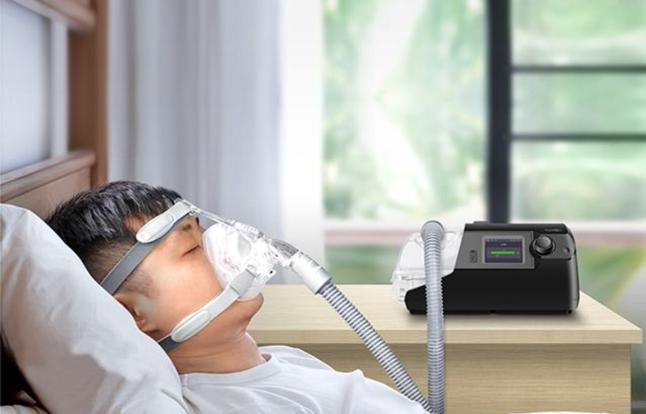Recently, many netizens have consulted "problems when using ventilators to treat snoring", and Xiaobian sorted out 4 questions that everyone was more concerned about, and interviewed Dr. Li Chenyang of the Sleep Center of Peking University People's Hospital.
Question 1: Wearing a ventilator has a feeling of suffocation, what is the cause of shortness of breath?
Li Chenyang:
This question can be considered in two ways, on the one hand, whether the patient has "claustrophobia". The use of a ventilator requires wearing a nose and mouth mask, which will cover the face, and people with "claustrophobia" will experience discomfort and cause a feeling of suffocation.
In this case, it can be suggested that the patient has a transition period, for example, in the waking state during the day, do not turn on the machine, and only wear a good mouth and nose mask to gradually adapt to themselves. In some patients, choking symptoms improve after passing the adaptation period. Of course, you can also choose a nose mask, which is smaller than the mouth and nose mask, which is helpful for improving discomfort.

▲Ventilator mouth and nose cover
▼Ventilator nose cover
On the other hand, it may be related to ventilator parameter settings. Especially when the breathing pressure is set too high, there will be difficulty breathing and a sense of resistance. Setting the breathing pressure too low will not have a therapeutic effect. Now many patients choose ventilators with automatic pressure regulation function, but the pressure is not set in stone, it is best to go to a professional doctor to do a pressure titration test before wearing, adjust a suitable treatment pressure, in order to facilitate positive pressure ventilation treatment through the home ventilator.
Dr. Li Chenyang reminds patients with apnea syndrome that if they have purchased a ventilator, it is best to carry their own ventilator when they go to the hospital for pressure drops, so that the doctor can better help with the deployment.
Question 2: After using a ventilator, wake up in the morning with a sore shoulder and back?
For people with sleep apnea syndrome, after using a suitable ventilator, the improvement of sleep quality is very impressive, a change in the phenomenon of tossing and turning before the inability to sleep, will sleep more deeply, more fragrant, which will lead to him in sleep for a long time to maintain a posture, may appear after waking up neck and shoulder back soreness.
There is also a possibility that some patients because of the first use of the ventilator, sleep at night when the ventilator is placed at the head of the bed, afraid of turning over and causing the respiratory mask to fall off or loose, so the whole night does not dare to move, maintain a posture to sleep, for a long time, there will also be shoulder and back pain.
In fact, after wearing a ventilator, you can maintain normal sleep habits, and the ventilator does not have any special requirements for the supine position. Moreover, the pipe of the ventilator linking the mask is generally relatively long, and any normal turning action during sleep will not affect its shedding. As long as the mask is worn correctly, there will be no leakage of too much air, so don't worry.
Question 3: Why do I still feel drowsy after using a ventilator?
One of the symptoms of sleep apnea syndrome is daytime drowsiness, which generally improves after receiving standardized ventilator treatment. If the patient also has narcolepsy, the first thing to consider is whether the ventilator is worn correctly. For example, is it appropriate to treat stress? Is there a large air leakage problem when wearing the mask? Does the night ventilator last more than 4 hours? ...... All of the above problems can affect the therapeutic effect of ventilators.
To achieve results with a ventilator, it is necessary to wear it for at least 4 hours at least 70% of nights.
Of course, if the above is all right, it may be necessary to consider whether there are other diseases that cause drowsiness, such as periodic leg movements or narcolepsy, etc., which also appear drowsiness.
After excluding other conditions, a small proportion of patients in the clinic will also have drowsiness during awakening after standardized treatment with ventilators, which is called "residual drowsiness". Once the diagnosis is confirmed, drowsiness symptoms can be relieved by medication under the guidance of a doctor.
Question 4: After using a ventilator in winter, do you have symptoms of sneezing and runny nose?
Clinically, this phenomenon is common, and the main reason is to pay attention to whether there is a problem with the setting of the humidifier gear of the ventilator and whether the moisture in the humidification tank is sufficient.
Ventilator therapy is called continuous positive pressure ventilation therapy, which is mainly through the nasal cavity to give continuous positive pressure ventilation therapy, will produce a certain stimulation of the nasal mucosa, nasal congestion leads to obstruction, if the patient has allergic rhinitis, it will induce the occurrence of rhinitis. In addition, the winter climate is relatively dry, and if the humidification of the ventilator is not enough, it will also induce rhinitis. At this time, the temperature of the ventilator can be appropriately increased to warm the humidifier, and if necessary, some nasal drops can be used to treat rhinitis drugs to alleviate the symptoms of rhinitis.
Expert Profile Li Chenyang
Ph.D. candidate, Sleep Center, Peking University People's Hospital
End of this article
Please do not reprint without permission
Typography: Golden Beans